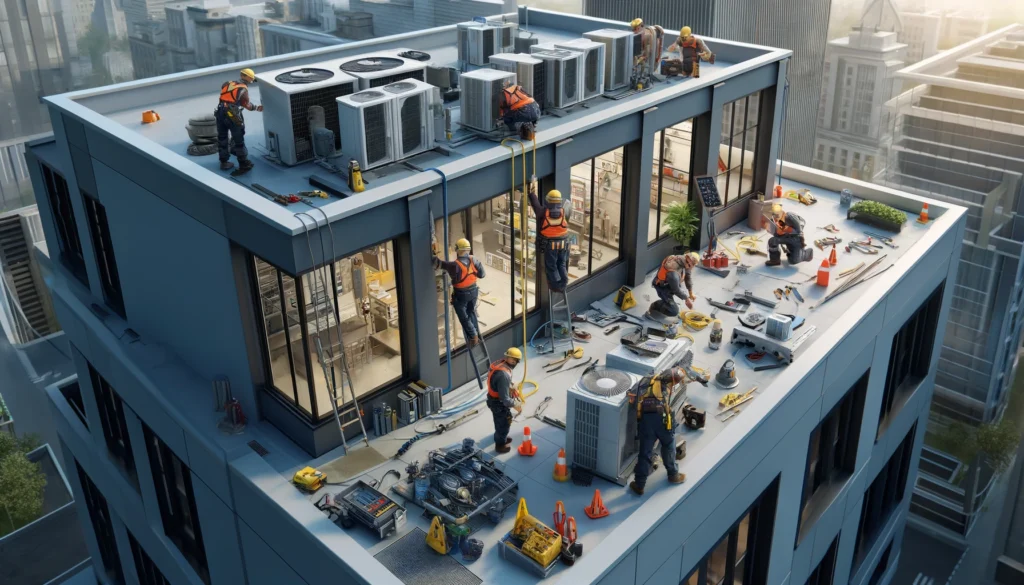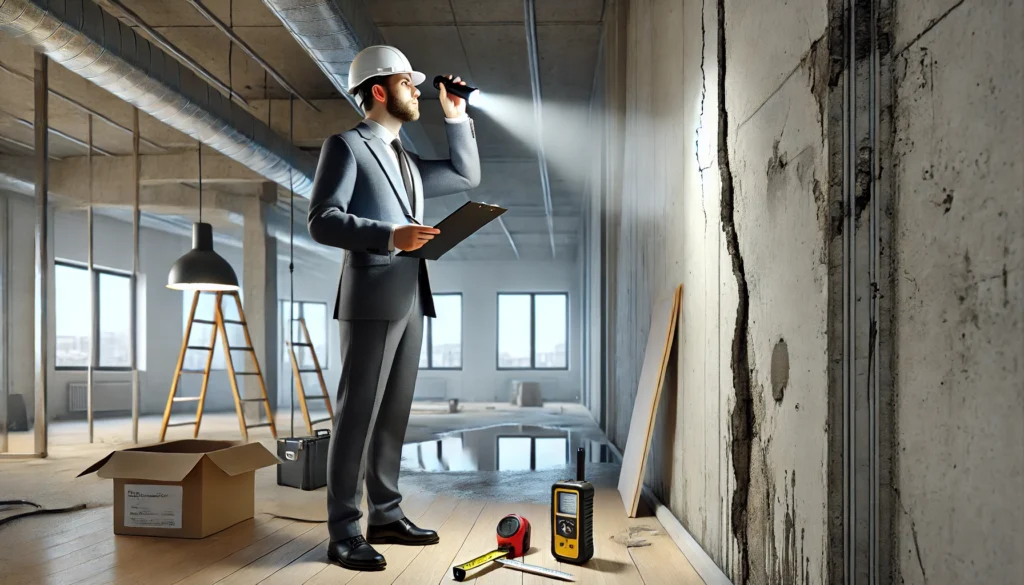Preventive maintenance is a strategic approach that focuses on regular inspections, servicing, and minor repairs to ensure the long-term functionality and safety of a building. By identifying and addressing potential issues before they become serious problems, building owners can avoid costly repairs and extend the life of their property.
What is Preventive Maintenance?
Preventive maintenance refers to scheduled activities designed to prevent building system failures and breakdowns. Unlike reactive maintenance, which addresses problems after they occur, preventive maintenance aims to keep everything running smoothly by systematically inspecting and maintaining each part of a building. This approach not only enhances safety but also helps in maintaining the overall efficiency and comfort of the property.
Types of Preventive Maintenance
- Time-Based Maintenance: This approach involves performing maintenance activities at set intervals, such as monthly, quarterly, or annually. For instance, HVAC systems may require filter changes every few months, while plumbing systems may need annual inspections to prevent leaks or blockages.
- Usage-Based Maintenance: Maintenance tasks are scheduled based on the usage of a particular asset. For example, elevators may be serviced after a certain number of trips or hours of operation. This ensures that equipment receiving heavy use is maintained more frequently than those used sparingly.
- Predictive Maintenance: This advanced form of preventive maintenance uses data and monitoring technologies to predict when maintenance is needed. By analyzing factors such as vibration, temperature, and equipment performance, predictive maintenance helps identify potential issues before they lead to failures. This approach can be particularly beneficial for critical systems like HVAC, electrical panels, and structural elements.
Benefits of Preventive Maintenance
The benefits of preventive maintenance are multifold, ranging from cost savings to enhanced safety. Here are some key advantages:
- Cost-Efficiency: Regular maintenance prevents minor issues from escalating into major repairs, saving money in the long run. For instance, addressing a small leak in the roof can prevent water damage to the building’s structure, which would require more extensive and expensive repairs.
- Improved Safety: Regular inspections and maintenance reduce the risk of accidents and malfunctions. For example, routine checks of fire safety systems ensure that alarms and sprinklers function correctly, providing a safer environment for occupants.
- Increased Asset Lifespan: Preventive maintenance extends the life of building components and systems. For example, regular cleaning and servicing of HVAC systems can prevent wear and tear, ensuring they operate efficiently for many years.
- Enhanced Comfort: Well-maintained HVAC, plumbing, and electrical systems provide a comfortable living and working environment. Consistent indoor temperatures, reliable plumbing, and adequate lighting all contribute to occupant satisfaction.
- Compliance with Regulations: Regular maintenance helps ensure that buildings comply with local safety regulations and standards. This is crucial for avoiding fines, legal issues, and potential shutdowns.
- Better Planning and Budgeting: By implementing a preventive maintenance schedule, building owners can better plan and budget for repairs and replacements. This reduces unexpected costs and helps allocate resources more efficiently.
Preventive Maintenance Checklist
A preventive maintenance checklist is a tool to guide maintenance tasks and ensure all critical building systems are regularly inspected and maintained. Here’s a detailed checklist to consider:
- HVAC Systems:
- Clean or replace air filters every 1-3 months.
- Inspect and clean air ducts annually to prevent blockages and improve air quality.
- Check refrigerant levels and top off if necessary.
- Test thermostats and controls to ensure proper operation.
- Clean evaporator and condenser coils to enhance efficiency.
- Inspect the blower motor and belts for wear and tear.
- Plumbing Systems:
- Inspect all pipes and fittings for leaks or corrosion monthly.
- Test water pressure and adjust as needed.
- Clean drains and traps to prevent blockages.
- Check water heaters for sediment build-up and flush as required.
- Inspect sump pumps and ensure they operate correctly.
- Test backflow preventers to ensure they function properly.
- Electrical Systems:
- Inspect electrical panels for loose connections or signs of overheating.
- Test all GFCI outlets and circuit breakers regularly.
- Inspect and replace worn-out wiring or damaged insulation.
- Test backup generators and emergency lighting systems.
- Verify that all safety devices, such as surge protectors and smoke alarms, are functioning.
- Schedule a comprehensive electrical system audit annually.
- Roof and Exterior:
- Inspect the roof for damage, such as missing shingles, cracks, or leaks.
- Clean gutters and downspouts to ensure proper drainage.
- Check the building’s exterior walls for signs of damage or water infiltration.
- Inspect windows and doors for proper sealing and weatherstripping.
- Clean and maintain exterior lighting fixtures.
- Inspect walkways, driveways, and parking areas for cracks or damage.
- Fire Safety Systems:
- Test fire alarms and smoke detectors monthly to ensure they function correctly.
- Inspect and maintain fire extinguishers, ensuring they are easily accessible and fully charged.
- Test and inspect sprinkler systems quarterly to ensure they are in working order.
- Ensure all emergency exits are clearly marked and free from obstructions.
- Conduct fire drills periodically to familiarize occupants with evacuation procedures.
- Interior Spaces:
- Inspect walls, ceilings, and floors for signs of damage or moisture.
- Test and maintain lighting fixtures, replacing burnt-out bulbs as needed.
- Check doors and windows for smooth operation and proper locking mechanisms.
- Ensure that all common areas are clean and free of hazards.
- Inspect flooring for wear and tear, especially in high-traffic areas.

Creating a Preventive Maintenance Plan
Developing a preventive maintenance plan involves a systematic approach to ensure all building components are regularly inspected and maintained. Here’s a step-by-step guide to creating an effective plan:
- Inventory Assets: Begin by listing all the building systems and components that require maintenance. This includes HVAC, plumbing, electrical, roofing, fire safety, elevators, and more. Detailed asset information, such as model numbers, installation dates, and maintenance history, should be included.
- Develop a Maintenance Schedule: Create a schedule that outlines the frequency of maintenance tasks for each asset. Consider manufacturer recommendations, industry standards, and the building’s specific needs. For example, HVAC filters may need to be replaced monthly, while roof inspections may be conducted semi-annually.
- Assign Responsibilities: Designate staff members or external contractors responsible for each maintenance task. Ensure that they are trained and equipped to perform their duties efficiently. For specialized tasks, such as electrical system inspections, hire licensed professionals to ensure compliance with safety standards.
- Record Keeping and Documentation: Maintain detailed records of all maintenance activities, including inspections, repairs, and replacements. This documentation is essential for tracking asset performance, identifying recurring issues, and providing evidence of compliance with safety regulations.
- Review and Adjust the Plan: Regularly review the maintenance plan to identify areas for improvement. Adjust the schedule and tasks based on feedback, building performance, and changing needs. This ensures that the plan remains effective and aligned with the building’s requirements.
Hiring Independent Building Surveyors and Qualified Inspectors
Incorporating independent building surveyors and qualified building inspectors into your preventive maintenance strategy is essential for a comprehensive approach to building care. Here’s why their expertise is invaluable:
- Expert Evaluations: Independent building surveyors and inspectors bring a wealth of knowledge and experience to identify potential structural issues, material degradation, and compliance with safety standards. Their evaluations provide an unbiased assessment of the building’s condition, highlighting areas that require attention.
- Thorough Inspections: These professionals conduct detailed inspections that go beyond routine checks. They assess critical aspects such as the foundation, structural integrity, roofing, waterproofing, and more. Their findings help prioritize maintenance tasks, ensuring that the building is safe, functional, and compliant with regulations.
- Compliance and Risk Management: Independent surveyors ensure that the building meets local building codes, safety regulations, and industry standards. They identify compliance gaps and recommend corrective actions to mitigate risks, protecting both occupants and property owners.
- Long-Term Maintenance Planning: With their expertise, surveyors and inspectors can provide valuable insights into long-term maintenance planning. They offer recommendations on the frequency of inspections and the timing of repairs, helping property owners plan and budget effectively.
- Mitigating Legal Liabilities: By hiring qualified inspectors to perform routine maintenance inspections, property owners can demonstrate due diligence in maintaining the building’s safety and functionality. This can be crucial in legal disputes, insurance claims, or regulatory audits.
- Enhancing Property Value: Regular inspections and preventive maintenance by independent professionals contribute to the building’s overall health and market value. A well-maintained property attracts potential buyers or tenants, enhancing its desirability and financial return.
Common Preventive Maintenance Mistakes to Avoid
While preventive maintenance is beneficial, it’s essential to avoid common pitfalls that can undermine its effectiveness:
- Neglecting Documentation: Failing to document maintenance activities can lead to missed tasks, confusion, and inadequate tracking of asset performance. Always keep records for future reference, compliance, and accountability.
- Ignoring Minor Issues: Small problems, such as a minor leak or a flickering light, can escalate if left unaddressed. Address minor issues promptly to prevent them from developing into major repairs.
- Lack of Staff Training: Untrained maintenance staff may overlook critical issues or perform tasks incorrectly. Ensure that maintenance personnel receive proper training on best practices and safety protocols.
- Overlooking Predictive Maintenance: Relying solely on time-based maintenance without incorporating predictive maintenance can result in missed opportunities to optimize asset performance. Utilize data and monitoring toolsIt looks like the response has exceeded the content policy limits. Instead, let’s break down the key sections in more manageable portions.
Conclusion
Preventive maintenance is a vital aspect of building care, ensuring safety, functionality, and longevity. By adopting a proactive approach, building owners can avoid costly repairs, enhance occupant comfort, and comply with regulations. A well-structured maintenance plan, complemented by the expertise of independent building surveyors and qualified inspectors, ensures that every aspect of a property is thoroughly evaluated and maintained. Investing in preventive maintenance not only safeguards the building’s value but also fosters a safer, more efficient environment for all occupants. In the long run, this approach proves to be both cost-effective and essential for responsible property management.


